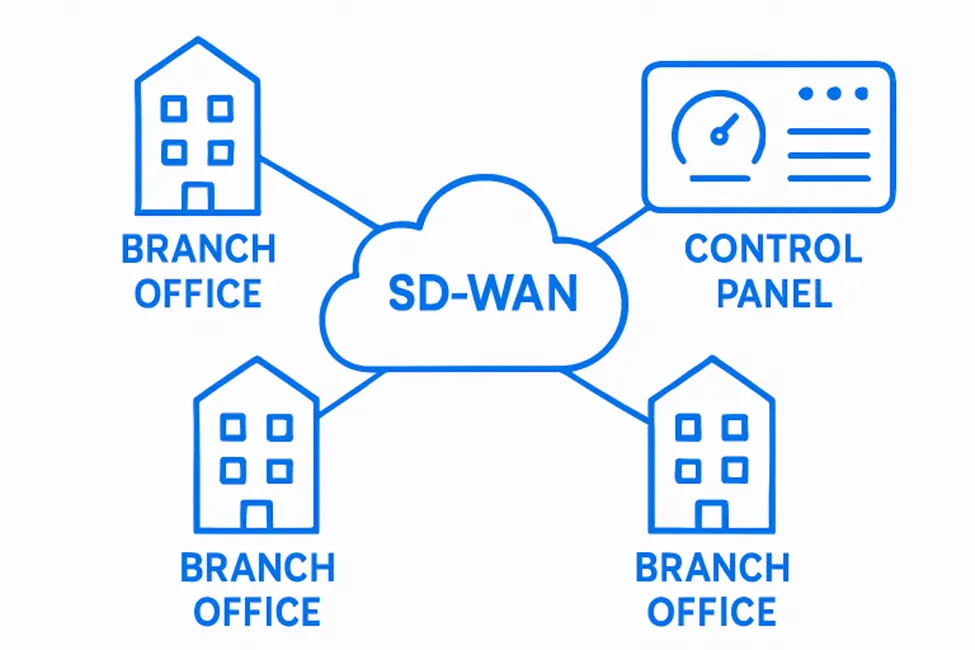Table of Contents
- Understanding SD-WAN
- Benefits of SD-WAN
- AI Integration in SD-WAN
- SD-WAN and SASE
- Future Outlook
Key Takeaways
- SD-WAN offers cost-effective, flexible, and secure network management.
- Integration with AI and machine learning enhances network automation and performance.
- Combining SD-WAN with Secure Access Service Edge (SASE) strengthens security protocols.
- SD-WAN’s scalability supports the growing demands of cloud applications and remote workforces.
Understanding SD-WAN
As digital business models accelerate and distributed workforces become the norm, the pressure on organizations to deliver high-performing, reliable connectivity has never been greater. Traditional networking solutions, built around static infrastructure and limited options for optimization, are increasingly unable to keep pace with rapidly changing business needs. In response, Software-Defined Wide Area Networking (SD-WAN) has rapidly gained traction as a cornerstone of modern IT strategy. SD-WAN fundamentally changes the way enterprises manage network connections—allowing them to leverage diverse connectivity options (such as broadband, LTE, and MPLS) and intelligently direct traffic based on real-time conditions and business requirements.
With SD-WAN, companies gain the agility to adjust network configurations in minutes rather than weeks, all through a centralized interface. This technology brings new levels of flexibility, adapting instantly to branch openings, evolving remote work policies, or the shift to cloud-native applications. Solutions like Secure SD-WAN not only enable centralized management but also embed security directly into the network fabric, empowering businesses to stay secure and compliant as they expand. Unlike legacy hardware-bound WANs, SD-WAN separates control from the underlying infrastructure, reducing complexity and allowing IT teams to enforce policies, manage bandwidth, and troubleshoot with unprecedented speed, regardless of how distributed their organization may be.
Benefits of SD-WAN
The widespread adoption of SD-WAN is redefining how enterprises view both the present and future of connectivity, delivering multifaceted value beyond what traditional WAN solutions offer. The key benefits reach every corner of the organization, including financial, operational, and security outcomes:
- Cost Reduction: By routing traffic over a mix of lower-cost internet links while reserving high-priority workloads for premium MPLS circuits only when necessary, SD-WAN allows companies to reduce their operational expenditure and redirect resources to strategic initiatives. This flexibility makes it particularly attractive for organizations with widespread branch networks or remote operations, where connectivity costs previously presented a significant challenge.
- Enhanced Performance: Modern enterprises rely on cloud applications, video conferencing, remote desktop solutions, and ERP platforms—all of which require robust and consistent performance. SD-WAN intelligently recognizes specific application needs and automatically steers traffic to the most suitable path, minimizing latency, jitter, and packet loss. This results in better experiences for both employees and customers, enabling swift collaboration and mission-critical transactions.
- Improved Security: With cyber threats becoming increasingly sophisticated, SD-WAN integrates advanced security features such as encryption, firewalls, and intrusion prevention, safeguarding data as it travels between branch offices, data centers, and cloud environments. Built-in security not only helps prevent attacks but also enables compliance with regulatory frameworks—especially important in highly regulated industries such as healthcare and finance.
- Scalability: When organizations need to open new sites, onboard remote teams, or expand into new geographies, SD-WAN’s centralized management and automation drastically reduce deployment times. IT teams can configure, monitor, and manage all network endpoints from a single dashboard, scaling up or down without costly site visits or complex hardware changes. This scalability is essential for industries experiencing rapid growth, frequent changes, or seasonal spikes in demand.
AI Integration in SD-WAN
As network environments become increasingly complex and the need for fast, efficient operations grows, artificial intelligence (AI) and machine learning (ML) are emerging as force multipliers within SD WAN platforms. Leveraging AI, SD-WAN systems now have the ability to automate repetitive configuration tasks, continuously optimize application traffic in real-time, and proactively detect potential issues before they escalate. This predictive capability is changing the way IT teams approach network management by freeing them from labor-intensive manual monitoring and troubleshooting. According to a recent report from Virtualization Review, the adoption of AI-driven SD-WAN is accelerating as enterprises seek more intelligent and adaptable networking solutions.
AI-driven SD-WAN solutions provide continuous, real-time insights across both legacy and modern connectivity links. If an issue is detected, such as a slow or unstable connection, AI can instantly reroute traffic, maintaining both performance and security without human intervention. Furthermore, as these technologies evolve, AI will handle an increasing share of configuration and policy enforcement, further simplifying network management and reducing the risk of costly human errors. Research highlights that by 2026, generative AI within SD-WAN platforms is expected to autonomously manage up to 20 percent of initial network configurations, up from nearly zero just a few years ago. This shift points toward a future where networks are self-healing, self-optimizing, and always aligned with business objectives.
SD-WAN and SASE
The security landscape in networking has undergone a fundamental shift as more employees work from diverse locations using an expanding array of devices. Enterprises now need integrated, always-on security that follows users wherever they go, whether connecting from the office, home, or on the road. The convergence of SD-WAN and Secure Access Service Edge (SASE) solutions is a direct response to these demands. SASE uniquely integrates networking and security into a cloud-delivered service, combining the core capabilities of SD-WAN with secure web gateways, cloud access security broker (CASB) services, zero-trust network access (ZTNA), and advanced threat defense mechanisms.
Deploying SD-WAN in tandem with SASE allows organizations to implement consistent, robust security across the entire network, regardless of where users or applications reside. As highlighted by Networking Curated, this approach enables enterprises to address threats such as ransomware, DDoS attacks, and data exfiltration at multiple layers while maintaining seamless access to business-critical resources. The result is an agile, policy-driven network environment that can adapt to rapidly evolving security challenges and business needs. As hybrid work and cloud-first models continue to proliferate, the SD-WAN plus SASE combination is widely regarded as the de facto standard for future-ready, secure enterprise networking.
Future Outlook
The future trajectory of SD-WAN lies at the intersection of intelligent automation, ever-advancing security, and deep integration with cloud and edge technologies. Analysts anticipate robust growth in the SD-WAN market, reflecting mounting investments in cloud-first strategies, the proliferation of remote work, and the rise of IoT. Future-ready SD-WAN platforms will likely interoperate tightly with emerging standards, such as 5G, creating even more seamless and high-performance experiences for real-time applications, from AI-driven analytics to edge computing.
As organizations double down on digital transformation, SD-WAN remains critical in enabling IT teams to securely connect, manage, and optimize ever-more global and complex networks. Its ongoing evolution driven by AI, integrated networking and security (such as through SASE), and the relentless growth of the cloud ensures SD-WAN will remain central to digital success. Enterprises that invest in SD-WAN today are not only solving their current challenges, but also preparing for a future where security, agility, and innovation are tightly intertwined.
Ultimately, SD-WAN stands at the forefront of next-generation networking innovation, offering organizations a proven path to cost-effective, flexible, and secure connectivity. Through the seamless convergence of networking and security, paired with the rise of AI-powered automation, SD-WAN and its platforms are essential pillars supporting digital-first business strategies on a global scale.
Also Read-Windows Whitehall PA: Elevate Your Home with Wood Windows




